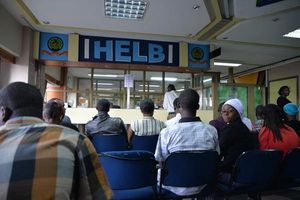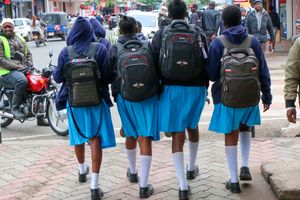
The implementation of the new university funding model opened the gates for universities to increase student fees, spawning a fresh crisis.
Of the six campaign promises President William Ruto made in his 2022 manifesto on higher education, only one has been accomplished successfully. To his credit, he awarded a charter to the Open University of Kenya and operationalised it.
However, his other promises either remain unfulfilled or his attempts have run into headwinds. These include the establishment of a National Skill and Funding Council to amalgamate the Higher Education Loans Board (HELB), the Technical, Vocational Education and Training (TVET), and the University Fund. Closely linked to this is the plan to increase funding to bridge the then 45 per cent gap.
Candidate Ruto had also promised to build a fully equipped TVET institution in 52 constituencies within the first two years and establish a one-year paid National Internship Programme for all students graduating from teachers, technical, and medical colleges, as well as universities. This would involve collaborating with industry players. All these promises remain unfulfilled.
The Kenya Kwanza team also promised to increase funding for research and development from 0.8 per cent to 2 per cent of the Gross Domestic Product (GDP), in accordance with the Science and Technology Innovation (ST&I) Act 2013, and incentivise the private sector to contribute towards research.
However, close to three years since assuming office, public universities still face an existential crisis, weighed down by delayed reforms, unresolved litigations, and a ballooning debt burden, with pending bills now totaling Sh72.2 billion.
The financial turmoil has cast a shadow over the country’s higher education sector, with 23 public universities now declared technically insolvent, according to Education Cabinet Secretary Julius Ogamba.
At the centre of the controversy is a funding model for higher education that was introduced months after President William Ruto assumed office.
What the President projected as the panacea to get universities out of financial morass has instead triggered widespread discomfort, forcing Dr Ruto to form a special committee to review the model.
However, months after the committee submitted its report, its recommendations remain hidden from public scrutiny.
The model is also the subject of a court case after the High Court declared it unconstitutional.
The new model replaced the Differentiated Unit Cost (DUC) and classified students into four bands — vulnerable, extremely needy, needy, and less needy — with state support weighted accordingly.
Those deemed "less needy" receive minimal support and are expected to seek loans. The categories were later revised to Band 1, Band 2, Band 3, Band 4, and Band 5 — with the first group being the neediest and the fifth applying to those who need the least state support.
"The process was marred by disorganisation, with unclear directives and a lack of transparency hindering the (special) committee’s work. We didn’t even know when to do what was suggested — we felt left out the whole time. We were just working blindly,” a source, who spoke in confidence for fear of victimisation, revealed.
The Cabinet Secretary for Education, Julius Ogamba, is on record saying that he had submitted the report of the committee to President Ruto. It aims to inform the next steps concerning the funding model and is intended to address gaps that were identified by the High Court.
The funding challenge is compounded by a Sh35.1 billion shortfall for the Higher Education Loans Board (HELB), whose budget allocation of Sh41.1 billion falls far short of the Sh76.3 billion required to adequately fund students under the new university financing model.
Economist Samuel Nyandemo has warned that public universities face imminent collapse unless urgent reforms are undertaken to address chronic underfunding and mismanagement.
Speaking during an interview, Dr Nyandemo said the current funding deficit of Sh72 billion in the higher education sector is unsustainable, with key institutions like the University of Nairobi weighed down by pending bills of over Sh13 billion.
“We cannot pretend to be moving in the right direction when we have a funding deficit of Sh72 billion in our public universities.
One of the key causes of this crisis is the very low competitiveness of our public universities. Many of them are mismanaged. Some vice-chancellors are incompetent and do not follow proper financial guidelines on how to spend the little money allocated by the government,” he said.
“There’s a need to rethink our financing formula and strongly consider public-private partnerships as an alternative stream of funding,” he added.
Dr Nyandemo said there is a need to review the university funding model to make it more sustainable, including increasing government contributions and possibly adjusting university fees.
Without this, he warned, “most of these universities will be insolvent,” severely affecting the quality of education and the country's ability to build a competent workforce.
“The current model of university funding must be reviewed. It is the only way to save our institutions from insolvency. If universities are allowed to charge reasonable fees under the proposed funding model, most of them can sustain themselves — but only if government support is also increased,” he said.
“With underfunding, universities are unable to invest in infrastructure and equipment. This leads to poor quality of service and ultimately affects the quality of graduates entering the workforce. If this trend continues, many universities will default on their obligations, including payments to suppliers and staff,” he added.
Among the universities with the highest accumulated debts are the University of Nairobi (Sh13.2 billion in pending bills), Technical University of Kenya (Sh11.1 billion), Kenyatta University (Sh10.6 billion), Egerton University (Sh10.1 billion), Jomo Kenyatta University of Agriculture and Technology (Sh9.13 billion), and Moi University (Sh7.83 billion).
Moi University has recently experienced prolonged strikes, delayed salaries, and a three-month closure due to staff unrest. The government eventually intervened with a Sh2.9 billion bailout to resuscitate operations.
While appearing before the National Assembly Committee on Education on Wednesday, March 19, Mr Ogamba revealed that 23 public universities in the country are insolvent. He admitted that the financial crisis in Kenya’s public universities has worsened over the years.
“The 23 public universities are technically insolvent due to underfunding. No resources are coming to allow deductions of pensions. Universities are struggling to meet financial obligations, including debts, operational costs, and staff salaries. Frequent disruptions in learning are affecting students’ academic progress,” he admitted.
The committee raised concerns about mismanagement and mounting debts in public universities, citing the University of Nairobi (UoN) and the Technical University of Kenya (TUK) as prime examples of institutions facing severe financial challenges.
“Mismanagement has been a key factor in the mounting debts and financial instability facing institutions like UoN and the TUK.
We cannot overlook the role leadership plays in either addressing or deepening these challenges. We are preparing a detailed response regarding the court’s decision to reinstate the degazetted University of Nairobi (UoN) council chairman, Amukowa Anangwe,” the Cabinet Secretary stated.
In May, in an op-ed, the Head of Public Service, Felix Koskei, announced a ban on new projects in 23 institutions, noting that the government would audit existing projects to track fund usage.
"A forensic audit is underway to trace cost escalations, expose mismanagement, and recover misallocated resources. With 23 public universities technically insolvent, financial sustainability is an imperative," read the article, in part.
However, the Chair of the Vice-Chancellors’ Committee of Public Universities in Kenya, Prof Daniel Mugendi, acknowledged that while the government has continued to release HELB funds and scholarships, there have been delays.
According to Prof Mugendi, universities have had to exercise financial prudence, stretching available funds to keep operations going. The situation, he said, has not reached a crisis point, but consistent, timely disbursements would significantly improve the institutions’ stability.
“There were moments when some universities struggled to pay salaries on time. But we’ve managed. The government has not defaulted — they have continued to honour their obligations, although not always promptly,” he said.
“Some universities have already cleared pending bills. The trend is improving. For example, by the end of 2023, the collective debt stood at around Sh8 billion. By June this year, that had dropped to Sh7 billion, and we expect further reduction by the close of the financial year,” he added.






